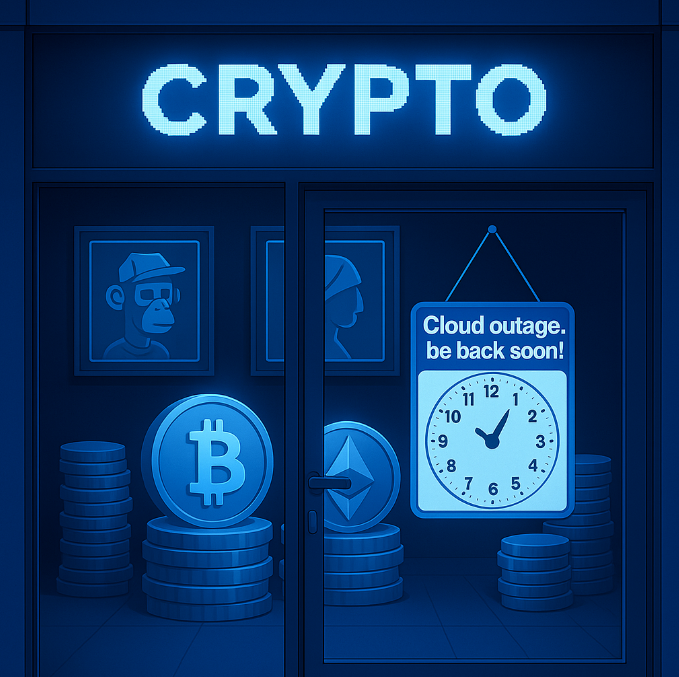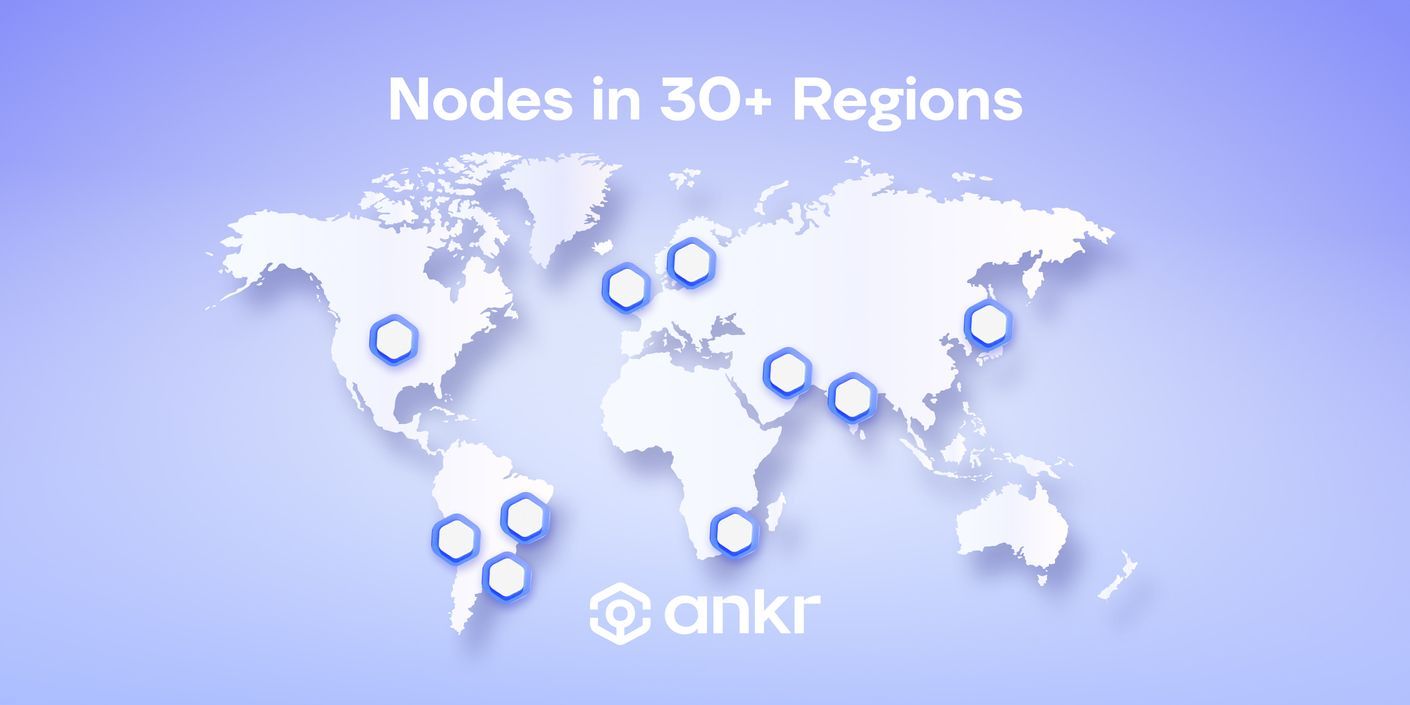Cloud Outages & Crypto: Improving Resilience & Decentralization for Unstoppable Systems

Kevin Dwyer
April 24, 2025
5 min read

On April 15, 2025, a familiar fault line reappeared beneath the foundations of the Web3 ecosystem.
Amazon Web Services (AWS), the dominant force in global cloud computing, suffered a regional outage in its Tokyo data center. The incident disrupted major crypto exchanges, with instances of failed order processing and a temporary withdrawal halt in many cases. While the issue was quickly resolved, the underlying message could not be clearer: the crypto industry remains reliant on centralized infrastructure.
This isn’t the first time. And it won’t be the last.
Cloud Reliance: A Recurring Vulnerability
The events of April 2025 echoed the scenarios we addressed in a 2022 article for Ankr, where heavily centralized node providers—particularly those relying completely on AWS—created systemic risks across the supposedly decentralized Web3 ecosystem. The same architecture remains: centralized platforms continue to run a large portion of their blockchain nodes within AWS-hosted environments.
Consequently, when cloud services falter, vast swaths of the crypto economy grind to a halt, as seen in many past headlines:
- Exchange Funds ‘SAFU’ After Amazon Web Services Error Stops Withdrawals
- Coinbase warns users of connectivity issues due to Amazon AWS outage
- Amazon Cloud Outage Caused Major Issues at Some Crypto Exchanges
- MetaMask stops working as Infura suffers another service outage
- Crypto Chaos as Amazon Web Services Outage Freezes Withdrawals
Cloud Expected For Enterprises, But Decentralized Systems Need Better

As we can see, many of the outages reported are for centralized exchanges, so some are to be expected, just like any other company relying on AWS (AWS and other top cloud services are the most used for a reason). However, decentralized wallets and exchanges can also fall victim to AWS outages if their blockchain node infrastructure providers rely on AWS for their services. If companies like Ankr exclusively used cloud services to power their blockchain nodes, the protocols that rely on communication with those nodes, like decentralized exchanges, would grind to a halt whenever there is a cloud outage.
Cascading failures are often the result of centralization failures – e.g., a node provider suffers a cloud outage, an NFT marketplace relying on it goes down, and subsequently, a social media platform relying on data from the NFT marketplace becomes non-functional. This cascading failure was not caused by a problem on the blockchain, but by centralized web infrastructure underpinning it.
In 2025, that same centralized fragility played out again, this time affecting exchanges at the very core of the global crypto economy. As Web3 platforms attempt to scale rapidly, many have simply replicated Web2's dependencies.
The Problem with Centralized Infrastructure
Outages are just one risk. A deeper issue lies in the contradiction between Web3's ideals and the operational reality of how many of its services run.
Single Points of Failure
When the nodes powering an exchange or dApp are concentrated in a handful of cloud zones, a localized disruption can disable global services. In the case of some exchanges, the EC2 instance failures in Tokyo temporarily knocked out order flow. These are not theoretical risks—they are recurring technical events.
Regulatory Leverage
Centralized cloud providers are subject to the jurisdictions in which they operate. If a government orders AWS or Google Cloud to cease services to a crypto exchange or dApp—due to sanctions, regulatory non-compliance, or political pressures—those platforms could be disabled overnight. Centralized infrastructure provides a backdoor for external control, which is antithetical to the core principles of blockchain and the crypto industry.
Censorship and Geofencing
We’ve already seen instances where centralized node providers geofenced blockchain access, effectively excluding certain users based on geography. This compromises Web3’s commitment to permissionless and censorship-resistant systems.
Ankr’s Bare-Metal Infrastructure: An Antidote To Failure
Ankr has spent years building our own global network of bare-metal nodes running for 75+ blockchains. There is a foundational difference between cloud-dependent node providers and Ankr’s approach. We've been building a global network of bare-metal servers and distributed validators that is not only technically distinct but ideologically consistent with Web3’s original vision.
That vision is proving its worth in 2025.
Whenever cloud providers experience an outage, Ankr’s infrastructure continues to operate, thanks to a globally distributed node architecture and load-balancing mechanisms that seamlessly fail over to other nodes when one becomes unavailable. This eliminates service interruptions and ensures continuity for Web3 platforms that rely on Ankr.
By distributing the infrastructure layer itself with physical node implementations, Ankr ensures that dApps and blockchains remain available and trustworthy even when centralized cloud services falter.
Learn more about bare-metal infrastructure →
Balancing Centralized Performance With Decentralized Ethos
To be clear, centralized cloud services like AWS have earned their dominance for good reason. Their performance, global scale, developer tooling, and enterprise pricing are often the most appropriate choice for large companies. It is understandable that exchanges and platforms use them in part to ensure high-performance user experiences.
However, that reliance should be carefully scoped, mitigated, and diversified wherever possible. The backend that powers core Web3 functionality—blockchain access, node infrastructure, protocol communication—must be made more independent of these centralized entities. Decentralization at the infrastructure level is not optional if Web3 is to remain truly open, unstoppable, and resilient.
Diversify your infrastructure with Ankr →
A Better Path Forward
Each major outage serves as a warning, a reminder that the Web3 industry remains too closely tied to the fragilities of Web2. But it’s also a call to action.
Projects that build on resilient, decentralized infrastructure like Ankr’s gain a real edge—not just in uptime and performance, but in trust. Ankr’s model proves that it is possible to scale Web3 infrastructure without sacrificing its foundational values.
Let the April 2025 AWS outage be remembered not just as another technical glitch, but as a turning point. The industry has the tools and models to decentralize its foundations. Now it must choose to use them.
Get started with distributed infrastructure →
Join the Conversation on Our Channels!
Twitter | Telegram | Discord | YouTube | LinkedIn | Instagram | Reddit | All Links
Similar articles.

Ankr Supports More Regions Than Any Web3 Infrastructure Provider

Kevin Dwyer
December 19, 2022

Web3 is a truly global movement that serves every country and corner of the world. The crypto industry never sleeps – and the 24/7 markets...

Ankr's RPC Performance Advantage: Global Bare-Metal Node Infrastructure

Kevin Dwyer
April 7, 2023

Web3 is a truly global movement that serves every country and corner of the world. The crypto industry never sleeps – and the 24/7 markets...



